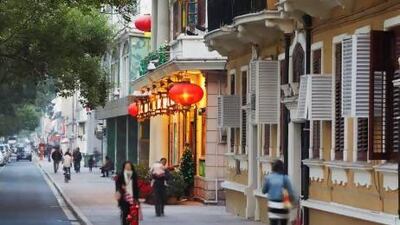Why Guangzhou?
Long before Hong Kong became the main gateway to China, Guangzhou served that purpose. In fact, ever since the Portuguese were first allowed into the city (in 1514), the sprawling metropolis, at the time known as Canton, has been one of China’s most important seaports.
Centuries of international exposure have led to a wealth of architecture and cultural exchanges that are still visible on the streets of the city. Colonial-era buildings and Chinese temples stand in proximity, while a sizeable African population and regularly visiting European and Middle Eastern traders continue to create a great blend of influences.
For all that, Guangzhou retains much of its own individual character. Its people, food and culture are unique to the region, and even its dialect sets it apart from the rest of China.
A comfortable bed
It's hard not to recommend the recently opened Four Seasons Hotel in Guangzhou's business district. A stunningly modern hotel that occupies the entire top third of the 103-storey Guangzhou International Finance Centre – one of the world's tallest skyscrapers – it is the pinnacle of luxury (and height) in Guangzhou. Rooms with a view to die for start at 2,080 yuan (Dh1,226) per night including taxes (www.fourseasons.com/guangzhou/; 00 86 20 8883 3888).
The Sofitel Guangzhou Sunrich is a great option for those wanting to stay in the city centre. Double rooms start from 1,300 yuan (Dh786) per night, including taxes (www.sofitel.com; 00 86 20 3883 8888). Finally, White Swan Hotel, located on picturesque Shamian Island, is currently undergoing large-scale renovation, but when it reopens in the New Year it is likely to reclaim its place among the top hotels in the city (www.whiteswanhotel.com; 00 86 20 8188 6968).
Find your feet
Anyone staying at the Four Seasons could do worse than heading out the door and checking out the nearby Guangzhou Opera House, a striking structure designed by the Pritzker prize-winning Zaha Hadid, also architect of the Sheikh Zayed Bridge and Performing Arts Centre in Abu Dhabi, among countless other projects. Nearby is the stylish Guangdong Museum, designed by Rocco Yim, and the Canton Tower (the world’s second-tallest free-standing structure after Dubai’s Burj Khalifa). Next, head to the older part of the city. Walk through the markets around Shang Jiu Road and savour the sights and smells of Chinese medicines and food on sale.
A short walk south from Shang Jiu will lead you to the small, man-made Shamian Island, once home to the city’s early European residents. With a 20-metre-wide moat on one side and Pearl River on the other, Shamian retains its impressive colonial European architecture, with grand buildings and wide, tree-lined boulevards. It has become a favourite spot for wedding photo shoots, so expect to share the island with hundreds of young couples at the weekend.
Meet the locals
The area around Haizhu Square has it all – green spaces, small alleys with shops spilling their wares into the street and, above all, friendly people. In the park itself, old men sit around playing their daily games of cards. Nearby, around the Cathedral of the Sacred Heart, the neighbourhoods are filled with pavement barbers, vendors selling snacks and the general clamour of daily life.
Book a table
Located in the older part of the city, Guangzhou Restaurant is quite rightfully hailed a culinary landmark in Guangzhou (2 Wenchang South Road), with three floors of crowded tables packed with locals and tourists. The dim sum on offer is delicious, and the range of meatballs, seafoods, noodles and vegetables truly overwhelming. Even after ordering a lot of small dishes, a meal is only likely to set you back 100 yuan (Dh60) per person.
Xin Li Zhi Wan (50 Shamian South Road) on Shamian Island is a great option for those looking for a quieter spot. The restaurant has a peaceful and ambient vibe, and the menu is filled with unexpected gems. The barbecued pigeon is particularly delicious, as are the soups and spinach dishes. Expect to pay upwards of 130 yuan (Dh80) per person.
Shopper’s paradise
Guangzhou is located at the heart of the Pearl Delta region, often known as the “factory of the world” and, as such, pretty much anything you might consider buying is available in the city. The OneLink Plaza near Haizhu Square is particularly impressive for the array of goods on offer – electronics, accessories, furniture, and all kinds of items you never even knew existed.
What to avoid
There is a saying among the Cantonese that they will “eat anything with four legs except a table, and anything that flies except a plane”. This is no idle boast. Anyone visiting Guangzhou should certainly experiment with the fabulous culinary offerings of the city, but be wary – menus often lack English translations and visitors who rely on pictures may find themselves eating bat stew or snake’s blood. If you’re unsure, find someone who can translate – or stick to vegetarian dishes.
Don’t miss
The vast Chen Clan Ancestral Hall, home to the Guangdong Museum of Folk Arts and Crafts, is a shrine to one of the most important families in the city and a former place of learning and trade for those who belonged to the Chen Clan. Built in 1894, the complex contains nine halls, six courtyards and meeting areas, all elaborately decorated with mythical creatures or episodes from Chinese legend carved into the stonework. It also hosts regular exhibitions.
Go there
A return flight with Emirates (www.emirates.com) from Dubai to Guangzhou takes about seven hours and costs from Dh3,190, including taxes.

